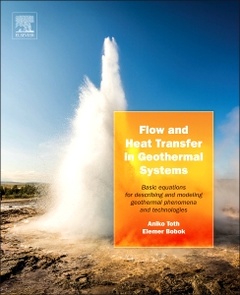Description
Flow and Heat Transfer in Geothermal Systems
Basic Equations for Describing and Modeling Geothermal Phenomena and Technologies
Authors: Toth Aniko, Bobok Elemer
Language: English
Subjects for Flow and Heat Transfer in Geothermal Systems:
Keywords
Abandoned mine; Air�water heat pumps; Angular momentum; Annular flow; Balance equations; Binary cycle; Blowout preventer; BNS equation; Borehole heat transfer; Cap rock; Cauchy�Riemann equations; Cavitation; Change of state of wet steam; Closed loop system; Compaction; Complex continuum; Complex potential; Conceptual model; Conduction; Conjugated velocity field; Consolidation; Convection; Cooled regions; Darcy's law; Deicing; Dissolved gases; Drilling fluid; Dry steam cycle; Efficiency; EGS; Energy; Entropy; Exponential integral; Flash cycle; Flashing; Flooded shafts; Flow patterns; Fractured geothermal reservoir; Free upflow; Friction factor; Geothermal energy; Geothermal gradient; Geothermal reservoir; Grash of number; HDR; Heat conduction; Heat exchangers; Heat flux; Heat source; Heat transfer; Hele�Shaw flow; High heat flow; History of geothermal use; Holdup; Hot water spray; Hydraulic reconstruction; Hydraulically smooth pipe; Hydrodynamic singularities; Hydrostatic equilibrium; Mantle flow; Mixing length; Momentum; Nusselt number; Overall heat transfer coefficient; Overpressure; Performance head; Performance parameter; Permeability; Plate tectonics; Pore fluid; Porosity; Power plant; Power-law; Prandtl number.Pressure waves; Relative roughness; Shallow boreholes; Shear-thinning fluid; Simultaneous fields; Static equilibrium; Steam blowout; Steam turbines; Stream function; Stress tensor; Superposition; Sustainable thermal power; T�s diagram; Temperature distribution.Temperature distribution; Terrestrial heat-flow; Theoretical head; Thermal conductivity; Thermal diffusivity; Thermal lift; Thixotropic fluid; Turbulent flow; Two-phase flow; Underground waste deposit; Velocity potential; Velocity triangles; Working cycle
116.98 €
In Print (Delivery period: 14 days).
Add to cartSupport: Print on demand
Description
/li>Contents
/li>Readership
/li>Biography
/li>Comment
/li>
Flow and Heat Transfer in Geothermal Systems: Basic Equations for Description and Modeling Geothermal Phenomena and Technologies is the ideal reference for research in geothermal systems and alternative energy sources. Written for a wide variety of users, including geologists, geophysicists, hydro-geologists, and engineers, it offers a practical framework for the application of heat and flow transport theory. Authored by two of the world?s foremost geothermal systems experts, whose combined careers span more than 50 years, this text is a one-stop resource for geothermal system theory and application. It will help geoscientists and engineers navigate the wealth of new research that has emerged on the topic in recent years.
Chapter 1. What Is Geothermal Energy?
Chapter 2. Basic Equations of Fluid Mechanics and Thermodynamics
Chapter 3. Transport Processes in Geothermal Reservoirs
Chapter 4. Heat Conduction in Rocks
Chapter 5. Natural State of Undisturbed Geothermal Reservoirs
Chapter 6. Two-Dimensional Steady Flow Through Porous Media
Chapter 7. Flow Through Producing Wells
Chapter 8. Artificial Lift by Submersible Pumps
Chapter 9. Heat Transfer in Wells
Chapter 10. Gathering System of Geothermal Fluids
Chapter 11. Geothermal Power Generation
Chapter 12. Propagation of the Cooled Region in a Small Fractured Geothermal Reservoir
Chapter 13. Borehole Heat Exchangers
Chapter 14. Flow and Heat Transfer During Drilling Operations
Chapter 15. A Case Study About a Serious Industrial Accident
Chapter 16. Miscellaneous Geothermal Applications
geologists, geophysicists, hydro- geologists, drilling and fluid production engineers, and power and environmental engineers.
Prof. Toth’s international reputation as a geothermal-energy researcher is such that she was selected to teach a summer course at the University of Colorado in 2014, 2015 and again in 2016. Prof. Toth’s research currently focuses on devising models to match various kinds of reservoir responses. These "inverse problems" seek the values of unknown reservoir parameters by inference rather than by direct measurement. Her specific interests are geothermal heat and flow transfer through porous materials, fractures, geothermal reservoirs, geothermal and CH wells, and geothermal surface facilities.
Elemer Bobok is Professor Emeritus of Petroleum Geology and Engineering at the University of Miskolc in Hungary. For more than forty years, his scientific rigor and practical experience has prepared numerous Hungarian and international students for their doctorate degrees, and helped them find success later on as professors and field engineers.
Recognized as an international expert on flow dynamics for the oil and gas industry, Prof. Bobok has more than 200 international publications to his credit. His classic 1993 Elsevier publication Fluid Mechanics for Petroleum Engineers, also available as an e-book, was written primarily to provide petroleum engineers with a systematic analytical approach to solving fluid-flow problems. In the years since thi
- Presents a practical and immediately implementable framework for understanding and applying heat and flow transport theory
- Features equations for modelling geothermal phenomena and technologies in full detail
- Provides an ideal text for applications in both geophysics and engineering




